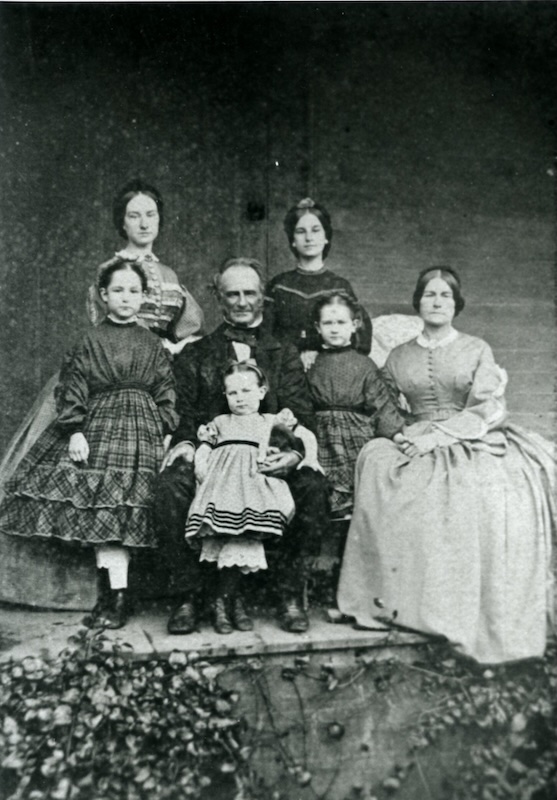
David and Charlotte Lansing in 1865 with their five daughters. Back row: Mary and Franny. Front row: Kate, David holding Helen, Julia, and Charlotte. (Alice Earl Wilder Collection, Kelley House Museum)
Continued from last Thursday…
When David Lansing arrived in Mendocino in 1852, his plans included bringing his family up from San Francisco as soon as possible. To make this possible, he built one of the first houses in Mendocino. Because the wood cut by the local mill was green rough stock, Lansing considered it unsuitable for the construction of a residence, so he purchased the lumber in San Francisco. Today the house is still standing across Main Street from the Presbyterian Church.
Lansing is credited with building the first railroad in Mendocino County in 1853. The railroad was about 180 feet long and was located at the west end of Main Street in Mendocino. Many more rails were laid until the Point was a maze of curved tracks that served the milled lumber storage area there.
Through a land deal with William Kelley, Lansing assumed ownership of all the land in Mendocino east of Lansing Street, north of Main Street, and south of Little Lake Road. In 1868, William Heeser surveyed and platted the town, naming the street on Lansing’s western boundary after him. Lansing donated the land for the first elementary school [near the northeast corner of Lansing and Ukiah Streets], and the local mill contributed the lumber. Lansing also served as a trustee for the school. In 1865, Lansing granted the land for the first Catholic Church vicarage [now it’s Patterson’s Pub] though he was not himself a Catholic.
Charlotte and David Lansing were instrumental in the founding of the Presbyterian Church, along with Jerome Ford and Peter Kelley, William Kelley’s father who had followed him here from Prince Edward Island. Lansing and Jerome Ford donated land on Main Street for the church building. Land sale records in the Kelley House archives show that Lansing’s largesse was made possible not only by his generosity, but also by the returns on his extensive holdings.
According to Walter Jackson’s book, “The Doghole Schooners,” [Mendocino Historical Research, 1977], Lansing was a very quiet, strong, and private man with a gruff personality. Not one to suffer extensive sermonizing gladly, he was known to stand with his hat in his hand waiting for the benediction at the back of the Presbyterian Church when Reverend David McClure attached an exceptionally long sermon to the scripture reading.
The Lansings had lost little Charlotte in 1851, but they had three more daughters in Mendocino: Katherine, Julia and Helen. The family flourished and was closely identified with the growth and prosperity of the town. When David died of a stroke on November 14, 1877, he was 68 years old. He was survived by four daughters; his wife and eldest daughter Mary had died in 1867. His daughter, Julia Lansing Morrow, inherited the house and, with her sister Helen, much of the property. When the sailor came home from the sea, he did very well.
His obituary noted his honesty and fair dealings in business affairs. Hundreds of people attended his funeral, one of the largest in early Mendocino’s short history (Mendocino Beacon, November 17, 1877). In respect to his memory, businesses closed and flags were displayed at half-mast. He and his wife and baby daughter are buried in Evergreen Cemetery.
— Excerpted and annotated from the Mendocino Historical Review, Spring, 1985.
The Kelley House Museum is open from 11AM to 3PM Friday through Sunday. Come by to see our current exhibit on the Northern Pomo. Walking Tours of Mendocino are available throughout the week; the cost is $25. Visit the Kelley House Event Calendar for a Walking Tour schedule.